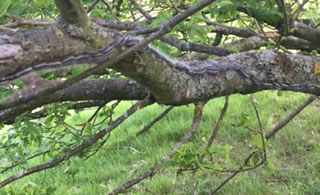Be Wary of The Hairy Caterpillars
Annual warning to avoid the Oak Processionary Moth
It's that time of year when residents in the borough are advised to keep children and animals away from the hairy caterpillars and their nests in oak trees.
The oak processionary moth (OPM) caterpillars have tiny hairs which contain a protein that can cause itchy skin rashes and, less frequently, eye and throat irritations and breathing difficulties in people and animals.
The greatest risk period is May to July, although nests should not be approached at any time as detached hairs remain within them. The Forestry Commission website has pictures to help identify the pest.
OPM has been managed on Wimbledon and
Putney Commons since 2011 and fortunately numbers remained very low during this period.
This year, however, there has been an increase
in the number of OPM caterpillars and nests
found by our survey teams and, possibly as a
result of the warmer weather, they have
emerged earlier than expected. During the
beginning of July, the caterpillars could be seen
in procession on a number of Oak trees around
the Commons.
 A spokesperson for WPCC told PutneySW15.com:
A spokesperson for WPCC told PutneySW15.com:
"
Many nests have also been found on branches
that are close to the ground - for this reason we
would advise parents to ensure that their
children are prevented from climbing oak
trees on the Commons in order to minimise
the risk of children coming into contact with
the caterpillars or nests of this pest."
Over the course of July, OPM survey teams will
continue to work on the Commons and removal
work will be carried out as soon as further nests
are found.
What to do if you find some OPM
caterpillars?
The advise from the Forestry Commission
is:
DO NOT touch or go near nests or
caterpillars
DO NOT let children touch or go near nests
or caterpillars
DO NOT let animals touch or go near nests
or caterpillars
DO NOT try to remove nests of caterpillars
yourself.
Ian Gambles, the Forestry Commission's Director England, said:
“The public can play an important role in helping to control the pest by reporting sightings. We need reports of the caterpillars or their nests from the public or others, such as gardeners, tree surgeons and ground-care workers, who work or relax near oak trees. However, they should not try to remove the caterpillars or nests themselves. This needs to be carefully timed to be effective, and is most safely done by specially trained and equipped operators.”
The Forestry Commission advises that the oak processionary caterpillars only build their nests on the trunks and branches of oak trees. They are never found among the leaves of an oak tree or on structures such as buildings, gates and fences, so caterpillars or nests in these situations need not be reported. They are only rarely found in other trees, and usually only if they run out of oak leaves to eat.
Anyone displaying symptoms including skin or eye irritations following possible OPM contact should visit a pharmacist, or call NHS111 for more-serious reactions. Contact a vet if an animal is affected.
More health advice is also available from the “Insects that bite or sting” area of the NHS Choices website,
Sightings should be reported to the Forestry Commission, preferably using its on-line Tree Alert form available at www.forestry.gov.uk/opm . Alternatively, residents can email opm@forestry.gsi.gov.uk or call 0300 067 4442.
1st July 2015